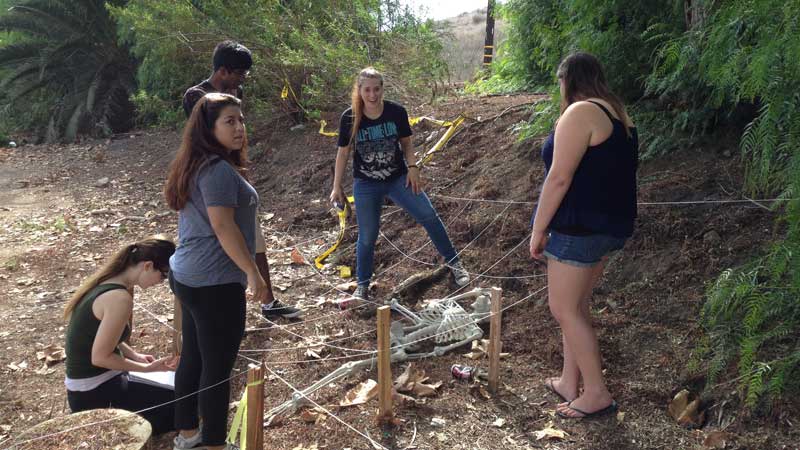The Anthropology Program at CI has a variety of facilities, equipment, and resources to assist student learning and professional development. The Program’s home base is in centrally Sierra Hall alongside the Central Mall. The space consists of two working laboratory classrooms and a dedicated workroom that supports teaching and research activities. The program has a full array of equipment and other resources for faculty and student to use including:
- Audio recording and transcription equipment
- Mapping equipment including GPS units, a Trimble, and a Topcon Total Station
- Field equipment and supplies such as compasses, tape measures, walkie-talkies, and coolers
- Collection of books, theses, and reports related primarily to California ethnography and archaeology
Students and researchers may arrange access to collections and equipment throughout the semester under the supervision of CI and visiting faculty. For information or access, contact Dr. Colleen Delaney.
Archaeology laboratory
The Archaeology laboratory is also a working laboratory used as a classroom and workspace for students and faculty. The archaeological collection available for class modules, laboratory exercises, and research contains artifacts and ecofacts from all over the world. Currently, the majority of the material available comes from European, Euro-American, and Native American locations across the United States, with an emphasis on southern California. We work closely with the local tribal groups who support continued student education through a variety of items and material types including shell, ceramics, flaked stone, and ground stone. The lab also contains measurement and analytical tools such as microscopes, scales, and calipers for training and research purposes. We also use this space for collaborative archaeological research and analyses with the Barbareño-Ventureño Band of Mission Indians.
Bioanthropology laboratory

The Bioanthropology laboratory is a working laboratory that is used as a classroom and workspace for students and faculty. The collection consists of a wide range of human and non-human primate specimens that illustrate human evolution. Non-human primate specimens consist of a variety of cranial casts and full disarticulated skeletons that illustrate morphological variation between species. Forensic material includes a variety of individuals and comparative casts for age-at-death, sex, stature, and trauma determination. Students have the opportunity to work with ethically sourced real human bone as well as high-quality plastic casts. Analytical tools available include microscopes, bone boards, and calipers. This laboratory also contains a comparative faunal collection that is used for forensic and archaeological research.
Workroom
The workroom is available for visiting researchers and current capstone students to review library materials and analyze material. Connected to the Anthropology laboratories, the space includes a ventilation hood for processing, a refrigerator for storage of sensitive material, and workbenches for research.
Outdoor experiential learning space

The Anthropology program has a new outdoor experiential learning space located next to the John Spoor Broome Library to conduct class activities such as flintknapping, mock excavations, and mapping exercises. Forensic anthropology students use the space to practice crime scene processing techniques
CI Park
University Park is a 367-acre parcel of land adjacent to CI that is used as an outdoor laboratory and an open space recreation area. The area has steep slopes of coastal sage and southern cactus shrub, wetlands, riparian habitat, and two small valleys. The Park also has features associated with the ranching and farming periods of Ventura County; these features are primarily associated with the State Hospital Dairy and Farm (1936-1967). Anthropology specifically uses University Park for training in field methods, and for student and faculty research projects. Past student projects include research related to native plants as well as historic archaeological sites (see Senior Capstones). Learn more about University Park
Santa Rosa Island Research Station (SRIRS)
The research station on Santa Rosa Island (SRIRS) is considered to be a CI undergraduate research campus. CI students and faculty utilize the facility for classes and research projects, and it is also available to outside school groups and researchers. Students have the opportunity to visit the research station every semester in the context of coursework and research, and they can receive funding for travel and lodging at SRIRS. Learn more about Santa Rosa Island Research Station (SRIRS)
Anthropology research and activities related to the SRIRS include:
- Assisting Channel Islands National Park in documenting and assessing cultural resources on Santa Rosa Island via cooperative research agreements and student service learning projects in coursework (Applied Anthropology, Archeological Method and Theory). Our emphasis is on the material culture of the historic ranching era.
Collecting data for student and faculty research projects related to historical archaeology and sociocultural anthropology. Senior Capstones have been directly related to research on the island, while others have been inspired by class visits to the SRIRS. Previous capstone topics include ranching and military history, graffiti, shipwrecks, and native plants.
